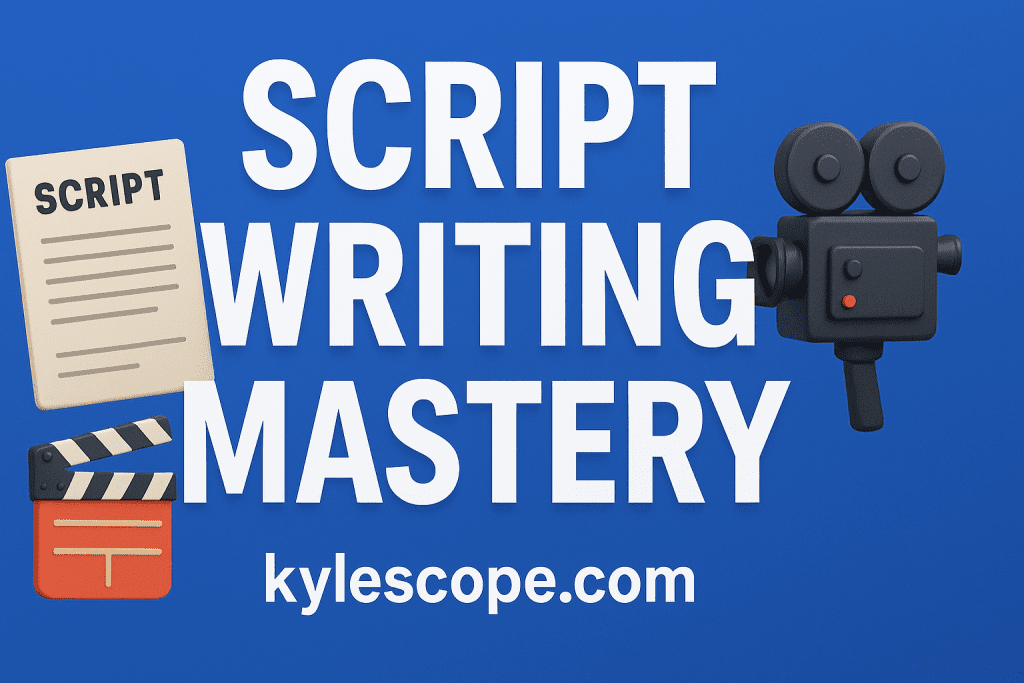
Introduction to Script Writing as a Creative Discipline
Script Writing represents the structured art of transforming imagination into visual and auditory experiences. It requires a balance of creativity, discipline, and technical knowledge. Successful writing for film and television begins with imagination, but it also requires a clear understanding of concepts, outlines, and a structured approach to storytelling. Unlike casual writing, this discipline demands precision because every word, action, and visual cue contributes to the final production.
One must transition from theory to practice. This means learning not only how to think creatively but also how to apply structured methods to produce scripts that can be directed and acted upon. The process involves imagination, concept development, outlining, and eventually complete script creation. Each stage builds upon the previous one, ensuring that the final product is coherent, engaging, and ready for production.
The Role of Imagination in Script Writing
Imagination forms the foundation of every strong script. The material emphasizes that imagination is the ability to create mental images and scenarios that do not yet exist. A writer must practice deep thinking to generate original concepts that stand out in a competitive industry. For example, the exercise of closing one’s eyes and imagining a film sequence demonstrates how mental visualization can lead to creative breakthroughs.
Writers must also train their imagination by consuming stories across different media. Reading fiction, watching films, and analyzing cultural narratives expand the creative reservoir. The course suggests watching films like Black Panther to understand how imagination translates into compelling storytelling. By stretching imagination, writers can create unique concepts that resonate with audiences. Without imagination, scripts risk becoming predictable and uninspired.
From Concept to Story: Building the Core Framework
A concept represents the central idea or theme that drives a script. The course material explains that a concept must be strong enough to sustain an entire narrative. For instance, the example of a world ruled by women illustrates how a simple idea can evolve into a complex story with characters, conflicts, and resolutions. The transformation of a basic logline into a more compelling version demonstrates the importance of word choice and framing.
Once a concept is established, it must be expanded into a story. A story is an account of events, incidents, and sequences that bring the idea to life. The story introduces characters, challenges, and solutions that keep audiences engaged. Writers must ensure that the story aligns with the concept while also providing depth and emotional resonance. This stage requires careful planning, as it sets the foundation for the outline and the eventual script.
Writing the Outline: Structuring the Narrative
An outline serves as the blueprint for the script. It condenses the larger story into key points and sequences that guide the writing process. According to the course material, an outline should capture the essential elements without going into full detail. This ensures that the writer maintains focus while leaving room for creativity during the actual writing phase.
The outline also introduces the critical elements of a script: dialogue, characters, action, and mise en scène. Dialogue drives the narrative by revealing character traits and advancing the plot. Characters embody the story’s themes and conflicts. Action provides momentum, while mise-en-scène ensures that the visual elements align with the narrative. Together, these elements create a cohesive framework that prepares the script for production.
Developing Characters and Dialogue
Characters form the heart of any script. The material emphasizes that characters must be fresh, distinct, and sometimes controversial. Writers should avoid creating characters that are entirely good or entirely bad. Instead, they should aim for complexity, with characters displaying both strengths and flaws. This approach makes characters more relatable and engaging.
Dialogue plays a crucial role in defining characters and advancing the story. Effective dialogue reveals personality, builds tension, and provides necessary exposition. However, dialogue must feel natural and purposeful. Writers should avoid unnecessary lines that do not contribute to the narrative. By combining strong characters with meaningful dialogue, writers can craft scripts that resonate with audiences and maintain their attention.
Writing for Documentary Formats
Documentary scripts differ from fictional scripts because they focus on reality. The course material explains that documentaries aim to inform and advocate rather than entertain. Writing a documentary script begins with selecting a theme and conducting thorough research. Credibility is essential, so writers must rely on both primary and secondary sources to gather accurate information.
The documentary script often follows a systems design approach, moving from cause to effect. This ensures that the narrative remains logical and impactful. The script is typically divided into visual and audio components, with visuals describing what appears on screen and audio providing narration, interviews, or sound effects. This dual structure ensures clarity and coherence, making the documentary both informative and engaging.
Music Video Scripts: Structure and Style
Music video scripts require a different approach. Unlike feature films or documentaries, music videos often rely on semi-scripted or improvised formats. However, the course material recommends using a run-down script that outlines the sequence of events from beginning to end. This ensures that the video aligns with the music while maintaining a coherent narrative.
Essential components of a music video script include theme, plot, structure, and style. The theme reflects the song’s message, while the plot organizes the visual progression. Structure ensures that scenes flow logically, and style demonstrates the director’s creative vision. Writers must balance these elements to create music videos that are visually compelling and thematically consistent.
Directing and the Role of the Script
Directing transforms a written script into a visual and auditory experience. The course material emphasizes that the director interprets the script, guiding actors, crew, and technical elements to bring the story to life. The director decides on camera angles, lighting, sound, and performance styles. This makes the script a crucial raw material for the director’s vision.
The director also coordinates the contributions of the entire production team. While the producer may have final authority, the director ensures that the script’s vision is realized on screen. This highlights the importance of writing scripts that are clear, detailed, and adaptable. A well-written script provides the director with the foundation needed to create a cohesive and impactful film.
Camera Movements and Visual Storytelling
Camera movements play a vital role in storytelling. The course material identifies various camera movements, including pan, tilt, zoom, truck, and dolly. Each movement serves a specific purpose, from adjusting composition to creating dramatic effects. For example, a zoom can emphasize a character’s emotions, while a dolly movement can reveal environmental details.
Writers must understand camera movements because they influence how scripts are interpreted. While the director ultimately decides on camera techniques, writers can suggest movements that enhance the narrative. This collaboration between writing and directing ensures that the final production aligns with the intended vision.
Framing Shots and Narrative Modes
Framing determines how audiences perceive characters and settings. The course material explains different types of shots, including close-ups, medium shots, long shots, and wide shots. Each shot serves a narrative purpose, from emphasizing emotions to establishing context. Writers must consider how their scripts translate into visual compositions.
Narrative modes such as establishing shots, reaction shots, inserts, and cutaways also play critical roles. These techniques help maintain continuity, build suspense, and guide audience attention. By understanding these modes, writers can craft scripts that are visually dynamic and narratively coherent.
Acting and Character Representation
Acting brings characters to life. The course material emphasizes that acting involves role play, where individuals temporarily suspend their own identities to embody fictional characters. Effective acting requires attention to physical, mental, psychological, spiritual, social, and economic dimensions of a character.
Actors rely on scripts to understand their roles. Writers must therefore provide clear character descriptions and dialogue that reflect these dimensions. By doing so, they enable actors to deliver performances that are convincing and relatable. This collaboration between writing and acting ensures that the story resonates with audiences.
Conclusion: Integrating Knowledge into Practice
Script Writing is a multifaceted discipline that combines imagination, structure, research, and collaboration. Successful scripts require careful planning, strong characters, meaningful dialogue, and an understanding of visual storytelling. Writers must also adapt their skills to different formats, including documentaries and music videos.
By mastering these elements, writers can create scripts that are not only engaging but also production-ready. The journey from imagination to final production requires discipline, creativity, and collaboration. Writers who embrace these principles will be well-prepared to contribute to the film and media industry.
Additional Resources for Learners
To deepen your understanding of writing for media, explore these resources:
- Learn more about professional writing techniques in this comprehensive guide.
- Explore opportunities for custom writing support through specialized writing-for-hire services.
- Discover tailored script development services at dedicated script solutions.
- Enhance your workflow with AI-powered writing tools for content creation with AI.
- For additional insights, review this external resource on screenwriting fundamentals.
Call to Action
If you are ready to transform your ideas into structured, production-ready scripts, consider seeking professional transcription and script development support. Utilize specialized script services to ensure your projects meet industry standards and captivate your audience.
